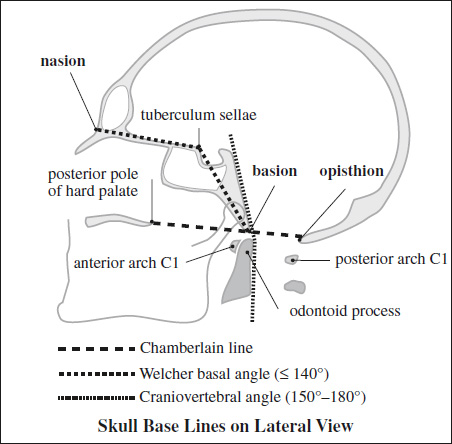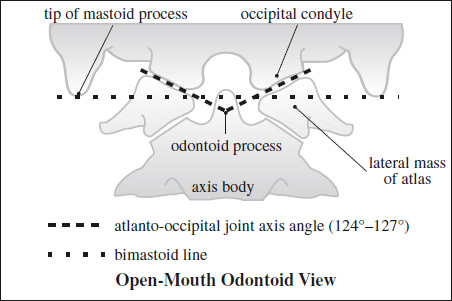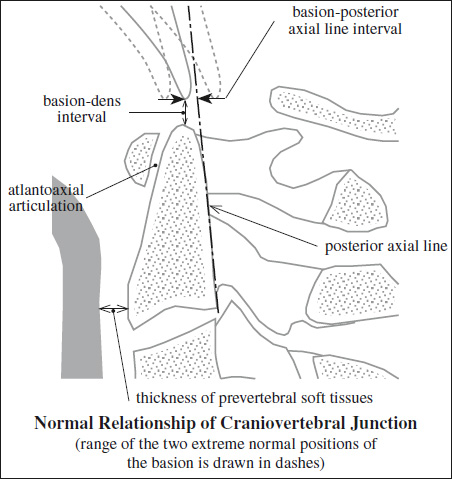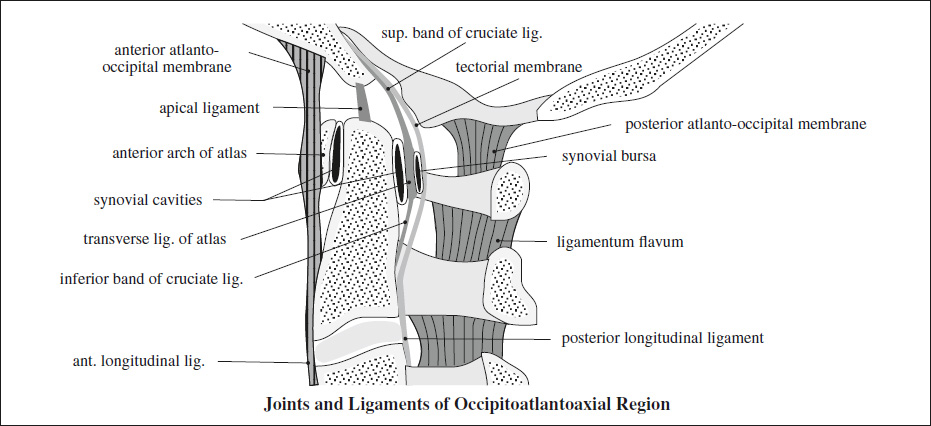CRANIOCERVICAL JUNCTION: C1 (atlas) + C2 (axis) + occiput
Variants of CVJ: precondylar tubercles, third occipital condyle, ossification of ligament of odontoid process
Craniometry:
- LATERAL VIEW
- Chamberlain line
= line between posterior edge of hard palate + posterior margin of foramen magnum (= opisthion)- tip of odontoid process usually lies below / tangent to Chamberlain line by >3 mm
- tip of odontoid process may lie up to 1 ± 6.6 mm above the Chamberlain line
- McGregor line
= line between posterior edge of hard palate + most caudal portion of occipital squamosal surface- Substitute to Chamberlain line if opisthion not visible
- tip of odontoid <4.5–5.0 mm above this line
- Wackenheim clivus baseline
= BASILAR LINE = CLIVAL LINE = line along clivus- usually falls tangent to posterior aspect of tip of odontoid process
- Craniovertebral angle = clivus-canal angle
= angle formed by line along posterior surface of axis body and odontoid process + basilar line- ranges from 150° in flexion to 180° in extension
- ventral spinal cord compression may occur at <150°
- Welcher basal angle
= intersection of nasion-tuberculum line and of tuberculum-basion line (along clivus)- angle averages 132° (should be <140–145°)
- McRae line
= line between anterior lip (= basion) to posterior lip (= opisthion) of foramen magnum- tip of odontoid below this line = NO basilar invagination; if poorly seen → Chamberlain line
- ANTEROPOSTERIOR VIEW (= “open-mouth” / odontoid view)
- Atlanto-occipital joint axis angle
= formed by lines drawn parallel to atlantooccipital joints- lines intersect at center of odontoid process
- average angle of 125° (range, 124° to 127°)




- Digastric line
= line between incisurae mastoideae (origin of digastric muscles)- tip of odontoid below this line
- Bimastoid line
= line connecting the tips of both mastoid processes- tip of odontoid <10 mm above this line
- Chamberlain line
Normal dimensions for adults:
[posterior axial line = vertical line drawn along posterior aspect of the subdental body of C2]
- Basion-dens interval (in 95%) <12 mm
- Basion-posterior axial line interval (in 98%)
posterior to dens <12 mm
anterior to dens <4 mm - Prevertebral soft tissues at C2 <6 mm
- Anterior atlanto-dens interval <2 mm
- Lateral atlanto-dens interval (side-to-side) <3 mm
- Atlanto-occipital articulation <2 mm
- Atlantoaxial articulation <3 mm
(for children <5 mm)
= ring-shaped vertebra
Composition:
- bilateral paired lateral masses
- superior articulation with occipital condyles = atlanto-occipital joints
- inferior articulation with C2 = atlantoaxial joints
- groove for vertebral artery on superior aspect
- anterior arch
- articular surface for odontoid process on dorsal aspect = atlantoaxial joint
- posterior arch
- attachment of posterior atlanto-occipital membrane
◊The only vertebra without a body / intervertebral disc!
Composition:
- Paired superior articular processes
- Paired inferior articular processes
- Superior projection = odontoid process / dens
